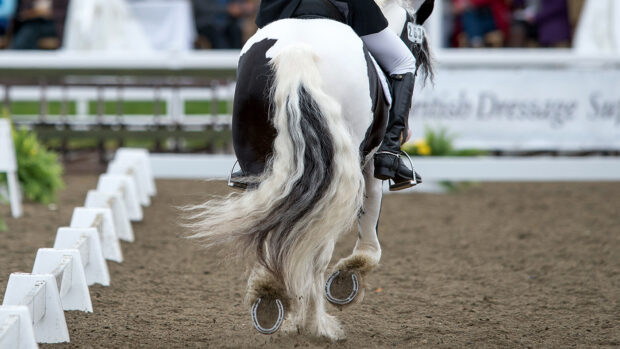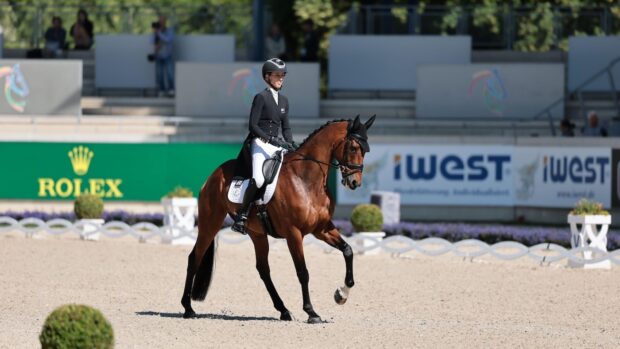Ever dreamt of coming home with more than one win under your belt? Sharon Lindop achieved just that at Gordon Dressage in Aberdeenshire and credits her success to the attention paid to the details by her trainer Jo Hamilton.
If you want to win, attention to detail is obviously the way. Trainer Jo Hamilton (nee Barry) had two pupils who were both double winners at Gordon Dressage, Aberdeenshire, last weekend (report Horse & Hound, 1 August). Sam Turpitt, riding her seven-year-old mare Busilus won both elementaries and Sharon Lindop won medium and advanced medium on her eight-year-old Sandhaven.
“Jo is really detail-orientated,” Sharon, who is aiming towards inter I, told us. So what are these details that gave Jo her winning hand of results this weekend?
What is it that you’ve been working on with Sharon?
We’ve been working on Sandhaven’s straightness and suppleness in the back, getting him to use his neck to engage.
But I think what Sharon’s referring to here is the recent work we’ve been doing about preparation for movements and how to set up a movement, such as a half pass, using visualisation through the corner. This helps her to plan what to do and to understand that preparation begins five or six strides before the marker.
I was taught that preparation is so important. If you have prepared properly, are in balance and have your horse going forward into a contact, the movement is far less complicated. If your horse is set up and enabled to do a movement you don’t have to make him do it.
What’s your USP?
I train from my own riding experience — I’m a girl, I’m small, I can’t ride through strength. I always ask the question “Why?”. This makes me look for a cause rather than at the symptoms, so if a horse doesn’t bend it’s because of what’s happening in its body not because its neck is stiff. I’m always going back and adhering to the basics. What I try to pass on is that if you don’t have basics established, there is no quick fix. There is always an ABCDEF [of how to progress your training] and if E and F don’t work you go back to ABC.
I also use lots of analogies to help people really understand. For example, I’m always reminding riders that the head and neck aren’t the main priority, but a reflection of what is happening in the body. Compare the head and neck to a vase of flowers sitting on a table — the body. If that table isn’t in balance it will rock and the vase and flowers will fall over.
What’s your pet hate?
Crookedness, either in rider or horse. How the rider sits in the saddle can really influence how the horse moves. It’s very easy for riders to believe their horse is crooked. Straighten the rider and the horse with follow.
Share with us your signature exercise
My standard exercise is in trot. Turn onto the centre line and leg yield to the wall, then ride a 10 or12m circle, depending on level of ability. From the circle, ride along the track either straight or progressing to riding shoulder-fore or shoulder-in. The leg yield softens the horse through the back, making him laterally soft, the circle is introducing bend and control through the shoulder, and then the shoulder-in, as the horse becomes more advanced, brings him on to the hind legs so you are developing collection.
Another favourite is shoulder-fore in canter, interspersed with 10m circles that get the horse to engage and sit. When you are using exercises all the time, it sometimes happens that the horse fights the exercise rather than the rider. Soften the horse and he can follow your direction much more easily. Then your rein aid becomes a directional aid rather than something negative to the horse.
What’s the best bit of advice you’ve ever been given?
Take time and remember to listen to the horse, as he will let you then feel what is happening. Riding is about communication and that’s a two-way thing — you have to give the horse a chance to respond so you can reassess and decide what your answer is going to be. If you don’t take a breathe you lose the ability to feel what is happening underneath you.
If we were to ask your pupils, what would be the one thing they all say you continually shout?
Outside rein!
For more about Jo’s teaching or to contact her please visit www.jobarryequestrian.co.uk



